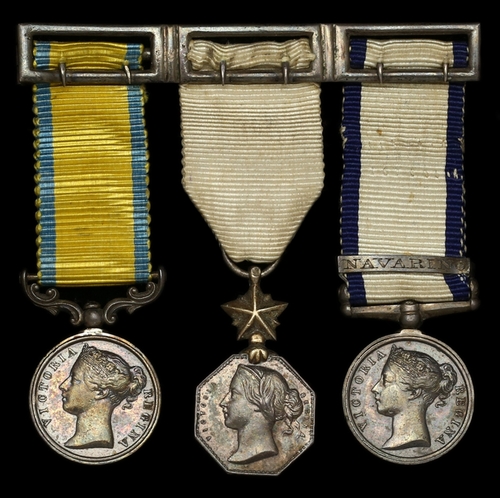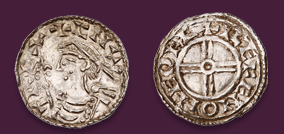
Auction: 25003 - Orders, Decorations and Medals
Lot: 331
The mounted group of three dress miniatures worn by Captain Sir E. Ommanney, K.C.B., Royal Navy, perhaps his most notable achievement was as commander of the Assistance during the 1850-51 search for the missing Franklin Expedition. It was Ommanney who personally discovered the Beachy Island Cairn, the first sign of the expedition to be discovered
Despite this he had a varied career being the last surviving officer to have taken part in the Battle of Navarino, leading to the unusual situation when- as the Senior Naval Officer in the service- he was presented with the Turkish Flag taken at that Battle
Baltic 1854; Arctic 1857; Naval General Service 1793-1840, 1 clasp engraved, Navarino, mounted as worn in that order by Hunt & Roskell with silver-gilt retaining pin, good very fine (3)
Note a photograph of the recipient depicts him wear his campaign awards in that order.
[K.C.B.] London Gazette 26 June 1902.
[Grand Cross of the Order of the Saviour] London Gazette 26 June 1890.
Erasmus Ommanney was born in London on 22 May 1814 the son of Georgina and The Right Honourable, Sir Francis Ommanney, M.P.. Notably his grandfather was Rear-Admiral Cornthwaite Ommanney and the nephew of Admiral Sir John Ommanney, K.C.B.
Entering the Royal Navy on 15 July 1826 under the auspices and command of his Uncle John, then Captain of HMS Albion as 1st Class Volunteer. In this roll he took part in the Battle of Navarino, aboard Albion, earning one of 21 Navarino clasps to officers of the ship. Interestingly, Ommanney was one of few officers young enough at that engagement to find himself fighting alongside the Turks against the Russians during the Crimean War.
Passing his examination for Lieutenant in 1833 he served as Mate aboard the packet service Pantaloon, not receiving his commission until 10 December 1835. Two weeks after this, he had his first taste of Polar Exploration, when he was posted to Captain James Clark Ross' HMS Cove.
This vessel was ordered to search for number of missing whalers near Greenland where they had been either iced in or caught out by drifting pack ice, the expedition was launched during winter conditions. Ommanney distinguished himself during this dangerous duty, earning a special commendation from the Admiralty for his conduct.
Post on to Pique on 7 October 1836 in the West Indies and later off Portugal he was transferred to Donegal as Flag Lieutenant to his uncle John, now a Rear Admiral and commander of the Mediterranean Station. Remaining in this role for the next three years Ommanney was advanced Commander on 9 October 1840 and posted to Vesuvius in 1841.
This vessel was again on the Mediterranean Station and had recently taken part in the bombardment of Acre. With her Ommanney was present for a bombardment of Tangier, however he left the ship upon his promotion to Captain on 9 November 1846. Transferred to Ireland he is recorded as performing 'valuable service' there as part of a Government Commission during the Irish Potato Famine in 1847. Elected a fellow of the Royal Geographic Society in 1845 he was later elected a Fellow of the Royal Society on 4 June 1848.
At this point Ommanney was posted to his first command as Captain, the Assistance a recently purchased Indian Merchantman which had been outfitted for Arctic service. They joined Sir Horatio Austen's 1850 mission to search for the missing 1845 Franklin Expedition, with Assistance being the second lead ship of the expedition beside Austen's Resolute.
Landing at Cape Yorke in August 1850 they picked up an Inuk guide named Qalaherriaq who aided them in the search. This guide volunteered to go with them, visiting England and Newfoundland and being baptized with the name of Erasmus Augustine Kallihirua, the first name a reference to Ommanney. Later that month Assistance stopped at Beechy Island where they discovered the first evidence of the Franklin Expedition, later proving that they had at one point wintered there. A sledge expedition turned up no additional evidence however Ommanney was credited with adding greatly to the map of Prince of Wales Land with a series of journeys totalling 480 miles in 60 days.
Returning to Britain, Ommanney was appointed Deputy Controller of the Coastguard, however he soon returned to active naval service on the outbreak of the Crimean War. Given command of Eurydice in 1854 he was posted to the White Sea and the blockade of Archangel. Notably here his squadron found themselves in the unusual position of exchanging fire with a monastery, the fortified Solovetsky Monastery constructed as a bastion of Christianity in the newly converted Siberia. Ommanney transferred to the command of Hawke in the Baltic the following year, being the most senior naval officer in the Gulf of Riga at the time.
Appointed Flag Captain on 13 November 1864 he was promoted Vice-Admiral on 14 July 1871. Ommanney was placed on the Retired List with the rank of Admiral on 1 August 1877 but remained heavily involved in naval affairs. Interestingly the Flag taken from the Ottoman Admirals at Navarino was being passed down to the longest serving officer in the Royal Navy- by Seniority- at the time. Ommanney reached this position in 1891 and with great irony as the last surviving officer to have fought in the Battle he was granted possession of the flag which he presented to King George I Greece in 1890.
When he fell ill in 1903 a summary of his career was posted in the West Gippsland Gazette, stating:
'A NAVAL VETERAN SIR ERASMUS OMMANNEY.
Sir Erasumus Ommanney, who was lying ill on May 18th, is one of the oldest sailors who have sailed under the British flag. He is an astonishing link with the historic past. He was in the King's Navy when Lord Liverpool was Prime Minister of England, and was fighting for his country before the grass had grown over Canning's grave. George the Fourth was on the Throne when he received his baptism of fire at Navarino, and it is amazing to remember that that battle was fought all but eighty years ago. Sir Erasmus Ommanney was there, under the command of Admiral Codrington, and he is perhaps, the only man now living who would give us a first hand description of what the Duke of Wellington called "that untoward event." Admiral Ommanney, in those far-off days, assisted at the landing of the British Army in Lisbon, helped to destroy the Turkish Fleet at Navarino, was on the yacht which conveyed Queen Adelaide to Holland and back, and explored the Arctics in search of the missing whalers under Sir James Ross. Few men can look back so far and say, "I was alive then"; but how many can look back, one wonders, and say, "I was present at that event?" Admiral Ommanney, seventy years ago and more, was helping to shape the history of the world. He is perhaps the only officer who has fought for England side by side with Russia and against her. He had around him at Navarino French and Russian troops, concentrating their strength upon the destruction of the Turkish and Egyptian fleet, and in later years, in the Crimea, he found himself commanding vessels whose guns were turned against his old comrades. He was closely associated with the fortunes of Greece in the early years of last century, and was at Athens during the revolution of 1844 and the establishment of the Constitution which followed. It would be almost as easy to say what Admiral Ommanney has not done as to say what he has done. It was he who found the first traces ever discovered of Sir John Franklin's lost ships. He spent the winter of 1850 as near the North Pole as he could get, and was sixty days in travelling 500 miles over the ice. His exploration of the coast added something to our knowledge of the Arctics. He has been at the other side of the world, too. Before Queen Victoria came to the throne Sir Erasmus Omrnanney was searching the Antarctic world for lost whaling crews. He was under the son of Sir John Ross, and has vivid memories of the winter he spent in Baffin's Bay and along the coasts of Greenland and Labrador. He has medals for these services to peace as well as distinctions for heroism in war, and it is not surprising that such a man has more letters after his name than there are in the alphabet. If he were well enough to follow it, Admiral Ommanney would be interested in the dawn of a new era in Ireland. There is hardly a place between the Poles which he has not known in the course of his wonderful life, and he has been in Ireland too.'
Ommanney died at St. Michael's Vicarage, Southsea on 21 December 1904, the Portsmouth Evening News describes his funeral:
'A fog hung over Mortlake on Tuesday afternoon when the remains of the late Admiral Ommanney were laid to rest. The coffin was brought to Wimbledon station, and thence by road to Mortlake Cemetery. In the same train travelled the Rev EA Ommanney (the eldest son), Mr E W Hansell (son- in-law), Commander E D Ommanney (a nephew), and a bearer party from the Royal Naval Barracks, Ports. At the graveside, awaiting the arrival of the coffin were Colonel Albert Ommanney, Captain Ommanney, Mr Charles Ommanney CMG, and Sir Montagu Ommanney (nephews), Colonel Monagu Ommanney and Colonel Edward Ommannel (cousins), Mr Edmund F T Bennett (a nephew by marriage) and Admiral Sir Digby Morant... The coffin, still covered with a Union flag, and having on it the late Admiral's cocked hat, sword, and scimitar - a Navarino trophy, which he highly prized - was borne from the hearse to the grave by six bluejackets. The seventh man of the party walked behind the coffin, and carried a cushion on which rested the late Admiral's orders and medals.'
Sold together with copied research.
Subject to 20% VAT on Buyer’s Premium. For more information please view Terms and Conditions for Buyers.
Estimate
£500 to £700
Starting price
£400




